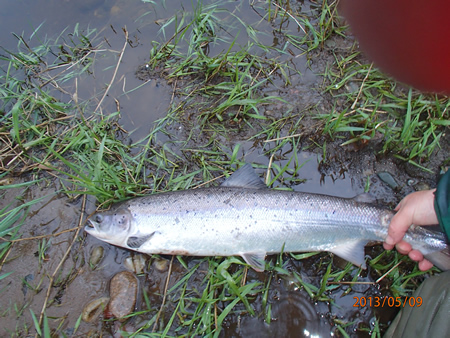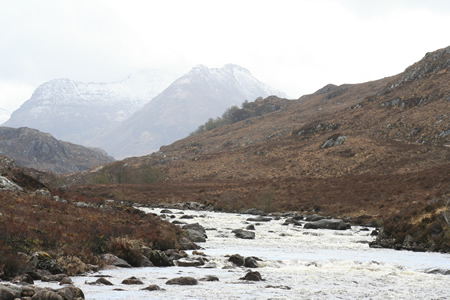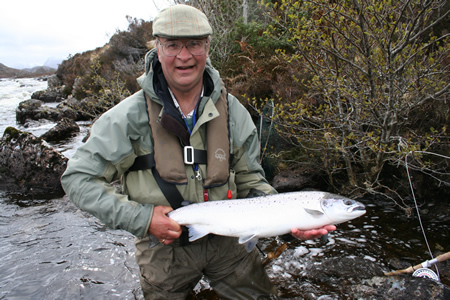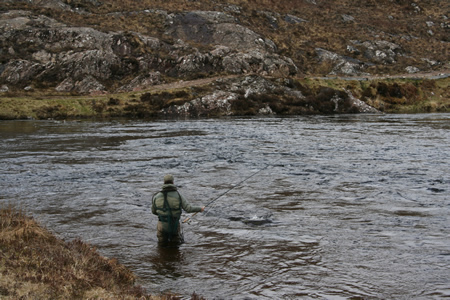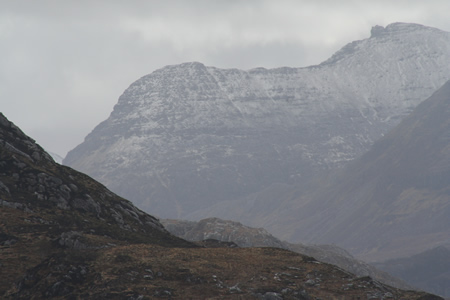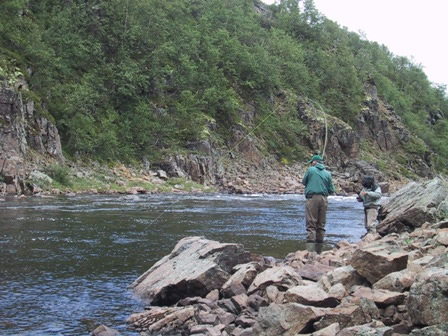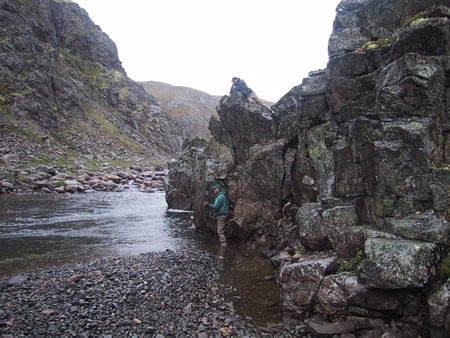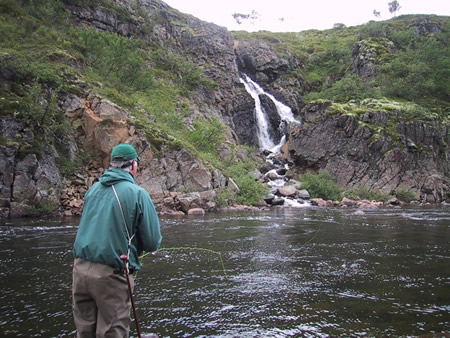These bulletin blogs represent news about Finavon and the South Esk, and my views as a riparian owner. While I may digress at times to write about other places, these are not the views of any other organisation, nor are they designed to promote the interests of any individual or organisation other than Finavon Castle Water and factors affecting the fishery. Tony Andrews
I lost a fish ‘on the dangle’ in Beeches yesterday evening (Wednesday). It was the only fish I saw in the 3 hours I spent on the river. It took the size 8 Finavon Whisp (very lightly dressed!) just above the Aqueduct. The water was peat stained and very clean, and at a perfect height for the twenty five yards of top quality fly water that comprises the Beeches Pool. There has been some flood damage to the right bank above the Aqueduct which has pulled trees into the river and opened up a large cavity in the bank. The preference of the river in a big spate at that point is to inundate the woods and the section of bank suffers as a result.
On Tuesday Derek had a nice 8lbs fish (see photo below)
This salmon was caught in the Flats on a Cascade. The best way to fish the head of the Flats, which is the ‘stopping’ area for travelling fish, is to stand above the RPJ (upstream ‘v’) at the tail of the Boat Pool and fish over the boulders. Derek’s fish took a little way down the pool where the turbulence starts to smoothen off. Over the years we have caught a number of spring salmon in this pool.
The week ending 11/5/2013 was quite productive with 6 fish landed and returned, and at least another four salmon lost in the process of catching them. My impression is that there is a steady trickle of fish entering the river, but not in any great numbers. To date the three middle river beats of Cortachy & Downie Park, Inshewan and Finavon Castle Water (FCW) have reported a total of 49 salmon caught and released. The five year average for salmon caught on these three beats between 16 February and 31 May is 52 salmon, so we are well on course at least to meet that average spring salmon catch figure.
The big difference in 2013 is the performance of the Kinnaird beats which, with the Marine Scotland netted and tagged fish in the Arn Pool (Upper Kinnaird), amounts to 70+ salmon. I think it is reasonable for us to assume that the South Esk will show a spring catch return in 2013 of about 200 rod caught and in-river netted (and tagged) salmon. Assuming a catch rate of about 20% – which may be a bit on the high side – we can guess (it is only an ‘educated’ guess!) that the spring component of the South Esk’s stock might be about 1,000 MSW salmon. Personally I think that figure may be on the low side. I have assumed for many years that the S Esk’s spring run is about 1,500 salmon.
Visit to the River Gruinard
Occasionally I am unfaithful to my local river. It doesn’t happen very often because I am hefted to the South Esk. If there is a river that can lure me away from Angus it is the Gruinard. The photographs below show some of the allure of that most beautiful of west highland rivers which, with the peerless wilderness of An Telleach, Ben Dearg and Strath na Shealagh as its backdrop, give the Gruinard River a setting that very few rivers anywhere in the world can match. There is one river that comes close, and that is the Sidirovka in Russias’s Kola Peninsular. I shall find some photos (see below) of the Sidirovka to explain my point.
Gruinard River. The Tree Pool with Ben Dearg in the background. The water was at a nice height to encourage early running salmon into the system, although the water temperature was only 7 degrees C. John’s salmon (see below) was caught in the lower section of the pool in the calmer water.
John Wood with his 11lbs fish from the Tree Pool, River Gruinard
In May there are not many salmon in the Gruinard; at least nothing like the shoals of grilse that enter the river in July and August – nor, as I remember from the 1960s, anything like the prodigious runs of sea trout that used to enter the river after the first spring tide in July every summer. In May therefore it is a matter of being in the right place at the right moment.
Travelling fish in relatively cold water, with six miles of river to swim through before reaching the relative safety of Loch na Shealagh, need to rest occasionally. Much of the river is cataract in character. Some of the pools are small ‘billiard tables’ in between long stretches of steep rocky gradients. While fishing the established pools is a sensible start, it is also important to employ a ‘fisherman’s eye’ to the water and work out where running salmon will want to pause in their upstream migration.
While talking to the estate manager, Bill Whyte, a salmon grabbed my fly while I was fishing a very small ‘billiard table’ in the centre of a rapid. Unfortunately that is all it did – grab the fly – and released it more or less immediately, which was the summation of my two days fishing. John meanwhile caught another salmon of 7lbs which had suffered seal or otter damage to its tail half of which was missing. So, for the two of us, two salmon in two days on a west highland river isn’t at all bad.
John Wood fishing the Bothy Pool at a good height for a resting fish, especially in the tail.
This photo (above) shows the view looking upstream towards Ben Dearg from the Bothy Pool. Loch na Sealga lies at the top of Strath na Shealagh and provides a refuge for salmon and sea trout as they await the autumn floods to take them into the upper catchment to spawn.
Sandwiched between An Telleach (‘The Anvil’) and Ben Dearg, and other surrounding mountains, the upper glen must be one of the most dramatic and unspoiled wilderness areas of the NW highlands. Fishing for salmon at any time of year in such aplace is a delight. To catch one there is very special indeed. On this visit I didn’t catch one, but I did net John Wood’s sea liced 11bs fish!
Comparing the Gruinard with Russia’s Sidirovka.
The photo above shows John Andrews playing a salmon in the Aquarium Pool of the Sidirovka, which is a small Kola Peninsular river close to the River Varzina. When I first visited the Sidirovka it struck me that in many ways it is similar to the two Gruinards. Certainly, in terms of the tackle needed to fish them, they have much in common.
Sidirovka River: A crystal-clear and deep pool with numbers of salmon easily spotted at different levels, some of which were very large (10Kgs+) and a predominance of grilse fresh from the sea. The River is at summer low level.
Comparing the Gruinard with the Sidirovka is a comparison of two rivers that share a number of features. While the mountain landscape of the Gruinard is far more dramatic than the Sidirovka’s quasi-tundra environment, the two rivers are of a similar size and, because they both are filtered by upper catchment lochs/lakes, their water is clear. Both rivers rise in remote areas and flow into the sea without passing any significant human habitations, except in the case of the Gruinard for a few houses beside the river close to the estuary.
Sidirovka River again: Fishing the Aquarium Pool by keeping the fly moving. The grilse in this river seem far more aggressive than our grilse in Scotland. I have often thought that this might be explained by the proximity of the marine feeding areas to the river and the consequent short time period between ceasing to feed and their arrival in the river.
The Sidirovka is much more remote, being accessible only by sea or helicopter (or by skis in the winter!) . The river is well inside the arctic circle and less than 1200 miles from the North Pole. Because of the short arctic summer the Sidirovka’s vegetation is more sparse than that of the Gruinard, and both landscapes are pretty much devoid of large trees. Both rivers are of course important spawning destinations for wild Atlantic salmon and sea trout. In the case of the Sidirovka there has been some human interference through introductions of hump backed (Pacific) salmon and Pink salmon. I hope that I continue to fish in both places for many more years!
TA on 15 May 2013
